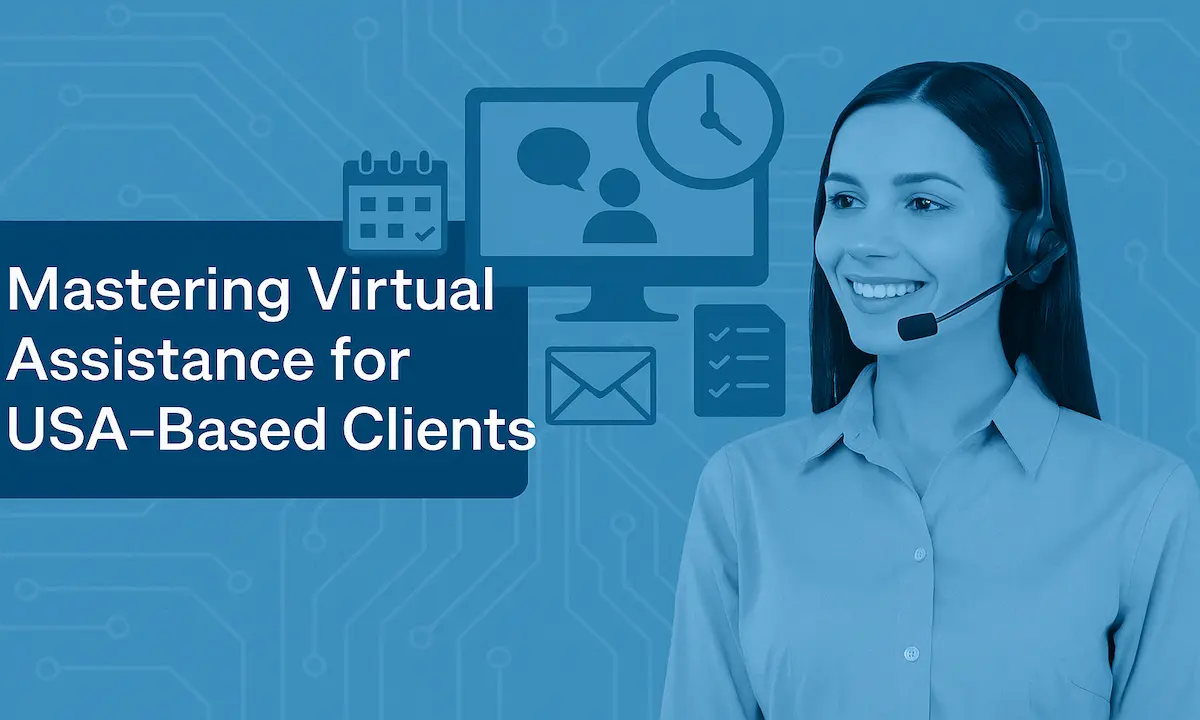Virtual assistance has become one of the fastest-growing remote professions globally, with U.S.-based clients leading the charge. As businesses shift toward flexible and cost-effective models, the demand for virtual assistants (VAs) is steadily rising.
This trend isn’t just about convenience—it’s about driving efficiency, reducing overhead, and accessing global talent.
In this article, we’ll explore how virtual assistants can effectively support U.S. clients, what skills are most sought-after, where to find opportunities, and how to build a successful long-term career.
Why U.S. Clients Hire Virtual Assistants
Understanding the motivation behind outsourcing is key. U.S. businesses choose VAs not just for affordability but for enhanced productivity and flexibility.
1. Cost Efficiency
Hiring full-time, in-house staff comes with high costs—salaries, benefits, taxes, and office space. Virtual assistants provide the same (or better) support at a fraction of the price.
2. Scalability
Startups and SMEs often need help that varies in intensity. VAs allow businesses to scale assistance up or down without long-term commitments.
3. Access to Global Talent
With VAs, U.S. clients aren’t limited to local talent. They can access skilled professionals from around the world, many of whom offer niche skills.
4. Focus on Core Business
Outsourcing repetitive tasks lets founders and executives focus on growth strategies rather than admin work.
Most In-Demand Skills for Supporting USA Clients
If you want to succeed as a VA for U.S. clients, developing the right skill set is crucial. Clients look for professionalism, efficiency, and adaptability.
Fluent English Communication
Whether through email, chat, or video, clear and professional communication in English is essential.
Reliability and Time Management
U.S. clients appreciate punctuality and consistency. Being available during U.S. business hours is often expected.
Technical Competency
Familiarity with common U.S.-preferred tools is a must:
| Category | Tools/Software Examples |
|---|---|
| Communication | Slack, Zoom, Microsoft Teams |
| Task Management | Trello, Asana, ClickUp |
| File Sharing | Google Workspace, Dropbox |
| Customer Service | Zendesk, HubSpot, Freshdesk |
Confidentiality and Integrity
VAs often access sensitive data, making trustworthiness a key factor in long-term client relationships.
How to Attract and Retain USA Clients
A strong online presence and thoughtful approach to client engagement make all the difference.
Create a Polished Online Profile
Platforms like Upwork, Freelancer, Fiverr, and LinkedIn are excellent starting points. Make sure to:
- Use a professional photo
- List skills, certifications, and tools
- Add client testimonials and case studies
Offer Value Upfront
Consider offering a free consultation, trial period, or discounted first month to gain trust.
Tailor Packages for U.S. Markets
Understand standard U.S. hourly rates and expectations. Create service bundles that offer clarity and value.
Be Culturally Aware
Familiarity with U.S. holidays, slang, time zones, and communication styles helps build rapport and prevent miscommunication.
Follow Up Regularly
Consistent, proactive communication shows commitment and fosters long-term relationships.
Common Tasks Handled by Virtual Assistants
VAs can support U.S. clients in a wide range of activities across departments. Here are some common tasks:
Administrative Support
- Email and calendar management
- Travel planning
- Document preparation
Customer Service
- Responding to inquiries
- Managing helpdesk software
- Following up on customer feedback
Social Media Management
- Scheduling posts
- Engagement and replies
- Analyzing performance metrics
Market Research
- Competitor analysis
- Data entry and presentation
- Survey setup and management
eCommerce Assistance
- Product listings
- Order tracking
- Refund coordination
Benefits of Working with U.S. Clients
Working with American clients offers some unique professional perks that many VAs find attractive.
Higher Pay Rates
U.S. clients are often willing to pay more for quality work, especially when it saves them money compared to hiring locally.
Career Growth Opportunities
Many VAs start part-time and transition into full-time project managers, coordinators, or even team leads.
Enhanced Exposure
International work experience boosts your resume, LinkedIn presence, and global recognition.
Read More: Master Your Credit Score with GomyFinance.com: Free Tools and Insights
Stable Contracts
Many U.S. businesses are looking for long-term, reliable talent rather than short-term freelancers.
Challenges and How to Overcome Them
Working with international clients also brings challenges. Being prepared can help you handle them with ease.
Time Zone Differences
Use shared calendars and tools like World Time Buddy to coordinate. Let clients know your availability.
Cultural Differences
Ask questions if unsure. Study basic U.S. business etiquette. Most clients appreciate transparency.
Communication Delays
Set clear expectations for response times. Tools like Slack and Loom help maintain daily communication.
Task Clarity
Use written instructions, checklists, or video walk-throughs to avoid misunderstandings.
Tips for Long-Term Success as a VA
Building a sustainable VA career supporting USA clients requires more than just technical skill. Soft skills and business acumen matter too.
Keep Learning
Stay updated with the latest tools and trends. Coursera, Udemy, and YouTube are great resources.
Ask for Feedback
Regularly check in with clients to improve performance. It shows maturity and professionalism.
Track Your Work
Use time trackers and reports to demonstrate productivity and value to clients.
Also Visit: Unlock Targeted Advertising Success with FeedBuzzard
Build a Portfolio
Keep screenshots, testimonials, and case studies of successful projects.
Join VA Communities
Groups on Facebook, Reddit, and Discord provide resources, job leads, and peer support.
Future of Virtual Assistance in the U.S.
The VA industry in the United States is expected to keep growing. More companies are embracing remote-first policies, increasing demand for trusted virtual support.
AI tools may change how basic tasks are done, but skilled VAs who can think critically, communicate clearly, and manage relationships will always be in demand.
Final Thoughts: Build Value, Deliver Results
Supporting U.S. clients as a virtual assistant can lead to a fulfilling and financially rewarding career. Success lies in offering value, being dependable, and always striving to improve.
Whether you’re just starting out or aiming to scale a VA business, consistency and professionalism will set you apart. With the right mindset and tools, there’s no limit to what you can achieve in this dynamic field.
FAQs
What are the most common tasks USA clients outsource to VAs?
Administrative work, email management, scheduling, social media, and customer support are among the top outsourced tasks.
Do I need to work during U.S. hours as a VA?
It depends on the client. Some require overlapping hours, especially for communication roles. Clarify expectations during onboarding.
How much can I earn as a VA supporting U.S. clients?
Rates vary based on skills and experience. Beginners might start around $8–$12/hour, while experienced VAs can charge $20–$50/hour.
What tools should I be familiar with as a VA?
Tools like Zoom, Slack, Google Workspace, Trello, and CRMs such as HubSpot or Salesforce are commonly used.
Is it necessary to have a certification to get hired?
No, but certifications in project management, digital marketing, or specific tools can enhance your credibility and attract more clients.












